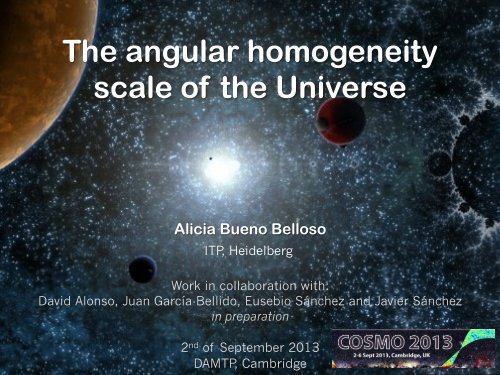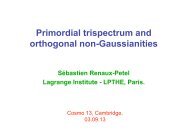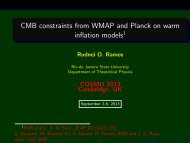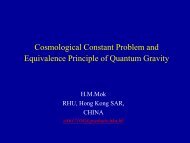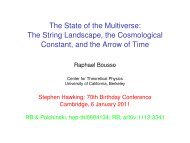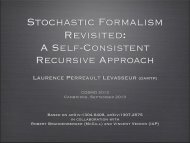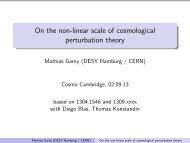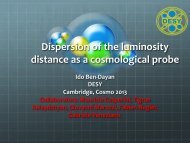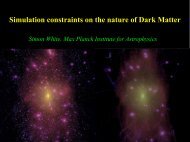The angular homogeneity scale of the Universe - Centre for ...
The angular homogeneity scale of the Universe - Centre for ...
The angular homogeneity scale of the Universe - Centre for ...
You also want an ePaper? Increase the reach of your titles
YUMPU automatically turns print PDFs into web optimized ePapers that Google loves.
<strong>The</strong> <strong>angular</strong> <strong>homogeneity</strong><br />
<strong>scale</strong> <strong>of</strong> <strong>the</strong> <strong>Universe</strong><br />
Alicia Bueno Belloso<br />
ITP, Heidelberg<br />
Work in collaboration with:<br />
David Alonso, Juan García-Bellido, Eusebio Sánchez and Javier Sánchez<br />
in preparation<br />
2 nd <strong>of</strong> September 2013<br />
DAMTP, Cambridge
Introduction: a homogeneous<br />
or fractal universe<br />
• Usual assumption: <strong>the</strong> <strong>Universe</strong> is homogeneous and isotropic on large <strong>scale</strong>s<br />
Alicia Bueno Belloso <strong>The</strong> <strong>angular</strong> <strong>homogeneity</strong> <strong>scale</strong> <strong>of</strong> <strong>the</strong> <strong>Universe</strong> 2 nd September 2013
Introduction: a homogeneous<br />
or fractal universe<br />
• Usual assumption: <strong>the</strong> <strong>Universe</strong> is homogeneous and isotropic on large <strong>scale</strong>s<br />
• Homogeneous regime is not realised on small <strong>scale</strong>s, due to <strong>the</strong> <strong>for</strong>m <strong>of</strong> <strong>the</strong><br />
spectrum <strong>of</strong> matter perturbations and to <strong>the</strong>ir evolution via gravitational collapse.<br />
Alicia Bueno Belloso <strong>The</strong> <strong>angular</strong> <strong>homogeneity</strong> <strong>scale</strong> <strong>of</strong> <strong>the</strong> <strong>Universe</strong> 2 nd September 2013
Introduction: a homogeneous<br />
or fractal universe<br />
• Usual assumption: <strong>the</strong> <strong>Universe</strong> is homogeneous and isotropic on large <strong>scale</strong>s<br />
• Homogeneous regime is not realised on small <strong>scale</strong>s, due to <strong>the</strong> <strong>for</strong>m <strong>of</strong> <strong>the</strong><br />
spectrum <strong>of</strong> matter perturbations and to <strong>the</strong>ir evolution via gravitational collapse.<br />
• <strong>The</strong> primordial spectrum <strong>of</strong> metric perturbations is predicted to be almost<br />
<strong>scale</strong>-invariant by inflation, still expect some level <strong>of</strong> inhomogeneities<br />
Alicia Bueno Belloso <strong>The</strong> <strong>angular</strong> <strong>homogeneity</strong> <strong>scale</strong> <strong>of</strong> <strong>the</strong> <strong>Universe</strong> 2 nd September 2013
Introduction: a homogeneous<br />
or fractal universe<br />
• Usual assumption: <strong>the</strong> <strong>Universe</strong> is homogeneous and isotropic on large <strong>scale</strong>s<br />
• Homogeneous regime is not realised on small <strong>scale</strong>s, due to <strong>the</strong> <strong>for</strong>m <strong>of</strong> <strong>the</strong><br />
spectrum <strong>of</strong> matter perturbations and to <strong>the</strong>ir evolution via gravitational collapse.<br />
• <strong>The</strong> primordial spectrum <strong>of</strong> metric perturbations is predicted to be almost<br />
<strong>scale</strong>-invariant by inflation, still expect some level <strong>of</strong> inhomogeneities<br />
• Different groups have argued that <strong>the</strong> <strong>Universe</strong> might not reach <strong>homogeneity</strong><br />
on large <strong>scale</strong>s, and that it behaves like a fractal…<br />
Pietronero. et al., 1997, Critical Dialogues in Cosmology, 24<br />
F. Sylos Labini, et al., Europhys. Letters 2009<br />
Alicia Bueno Belloso <strong>The</strong> <strong>angular</strong> <strong>homogeneity</strong> <strong>scale</strong> <strong>of</strong> <strong>the</strong> <strong>Universe</strong> 2 nd September 2013
Introduction: a homogeneous<br />
or fractal universe<br />
• Usual assumption: <strong>the</strong> <strong>Universe</strong> is homogeneous and isotropic on large <strong>scale</strong>s<br />
• Homogeneous regime is not realised on small <strong>scale</strong>s, due to <strong>the</strong> <strong>for</strong>m <strong>of</strong> <strong>the</strong><br />
spectrum <strong>of</strong> matter perturbations and to <strong>the</strong>ir evolution via gravitational collapse.<br />
• <strong>The</strong> primordial spectrum <strong>of</strong> metric perturbations is predicted to be almost<br />
<strong>scale</strong>-invariant by inflation, still expect some level <strong>of</strong> inhomogeneities<br />
• Different groups have argued that <strong>the</strong> <strong>Universe</strong> might not reach <strong>homogeneity</strong><br />
on large <strong>scale</strong>s, and that it behaves like a fractal…<br />
• … while o<strong>the</strong>r groups claim <strong>the</strong> opposite result!!<br />
Pietronero. et al., 1997, Critical Dialogues in Cosmology, 24<br />
F. Sylos Labini, et al., Europhys. Letters 2009<br />
Scrimgeour, M., et al., 2012, MNRAS, 425, 116<br />
Nadathur, S. 2013, MNRAS, 434, 398<br />
Alicia Bueno Belloso <strong>The</strong> <strong>angular</strong> <strong>homogeneity</strong> <strong>scale</strong> <strong>of</strong> <strong>the</strong> <strong>Universe</strong> 2 nd September 2013
Introduction: a homogeneous<br />
or fractal universe<br />
• To measure this transition observationally, large survey volume is necessary<br />
Alicia Bueno Belloso <strong>The</strong> <strong>angular</strong> <strong>homogeneity</strong> <strong>scale</strong> <strong>of</strong> <strong>the</strong> <strong>Universe</strong> 2 nd September 2013
Introduction: a homogeneous<br />
or fractal universe<br />
• To measure this transition observationally, large survey volume is necessary<br />
• Ideal <strong>for</strong> photometric galaxy redshift surveys such as DES<br />
<strong>The</strong> Dark Energy Survey Collaboration, arXiv:0510346, 2005<br />
Alicia Bueno Belloso <strong>The</strong> <strong>angular</strong> <strong>homogeneity</strong> <strong>scale</strong> <strong>of</strong> <strong>the</strong> <strong>Universe</strong> 2 nd September 2013
Introduction: a homogeneous<br />
or fractal universe<br />
• To measure this transition observationally, large survey volume is necessary<br />
• Ideal <strong>for</strong> photometric galaxy redshift surveys such as DES<br />
Due to photometric uncertainty<br />
Radial in<strong>for</strong>mation is lost<br />
<strong>The</strong> Dark Energy Survey Collaboration, arXiv:0510346, 2005<br />
Alicia Bueno Belloso <strong>The</strong> <strong>angular</strong> <strong>homogeneity</strong> <strong>scale</strong> <strong>of</strong> <strong>the</strong> <strong>Universe</strong> 2 nd September 2013
Introduction: a homogeneous<br />
or fractal universe<br />
• To measure this transition observationally, large survey volume is necessary<br />
• Ideal <strong>for</strong> photometric galaxy redshift surveys such as DES<br />
Due to photometric uncertainty<br />
Radial in<strong>for</strong>mation is lost<br />
Must use estimator with only <strong>angular</strong> info<br />
Advantage: Angles are model-independent!<br />
<strong>The</strong> Dark Energy Survey Collaboration, arXiv:0510346, 2005<br />
Alicia Bueno Belloso <strong>The</strong> <strong>angular</strong> <strong>homogeneity</strong> <strong>scale</strong> <strong>of</strong> <strong>the</strong> <strong>Universe</strong> 2 nd September 2013
<strong>The</strong> fractal dimension<br />
• To study <strong>the</strong> transition to <strong>homogeneity</strong><br />
fractality <strong>of</strong> <strong>the</strong> galaxy<br />
distribution<br />
Alicia Bueno Belloso <strong>The</strong> <strong>angular</strong> <strong>homogeneity</strong> <strong>scale</strong> <strong>of</strong> <strong>the</strong> <strong>Universe</strong> 2 nd September 2013
<strong>The</strong> fractal dimension<br />
• To study <strong>the</strong> transition to <strong>homogeneity</strong><br />
fractality <strong>of</strong> <strong>the</strong> galaxy<br />
distribution<br />
• Fractal dimension is also useful to quantify clustering<br />
Alicia Bueno Belloso <strong>The</strong> <strong>angular</strong> <strong>homogeneity</strong> <strong>scale</strong> <strong>of</strong> <strong>the</strong> <strong>Universe</strong> 2 nd September 2013
<strong>The</strong> fractal dimension<br />
• To study <strong>the</strong> transition to <strong>homogeneity</strong><br />
fractality <strong>of</strong> <strong>the</strong> galaxy<br />
distribution<br />
• Fractal dimension is also useful to quantify clustering<br />
• How do we specify this<br />
Correlation integral<br />
C 2 (r) = 1 N<br />
NX<br />
nP (n; r, N) / r 3<br />
n=0<br />
D 2 (r) ⌘ d log C 2(r)<br />
d log r<br />
! 3<br />
Volume<br />
As <strong>homogeneity</strong><br />
is approached<br />
Alicia Bueno Belloso <strong>The</strong> <strong>angular</strong> <strong>homogeneity</strong> <strong>scale</strong> <strong>of</strong> <strong>the</strong> <strong>Universe</strong> 2 nd September 2013
<strong>The</strong> fractal dimension<br />
• To study <strong>the</strong> transition to <strong>homogeneity</strong><br />
fractality <strong>of</strong> <strong>the</strong> galaxy<br />
distribution<br />
• Fractal dimension is also useful to quantify clustering<br />
• How do we specify this<br />
C 2 (r) = 1 N<br />
NX<br />
nP (n; r, N) / r 3<br />
Correlation integral<br />
• Departures from D 2 = 3 due to:<br />
- Clustering<br />
- Shot noise<br />
n=0<br />
D 2 (r) ⌘ d log C 2(r)<br />
d log r<br />
! 3<br />
Volume<br />
As <strong>homogeneity</strong><br />
is approached<br />
J. S. Bagla, J. Yadav and T. R. Seshadri, 2007, MNRAS, 390:829<br />
Alicia Bueno Belloso <strong>The</strong> <strong>angular</strong> <strong>homogeneity</strong> <strong>scale</strong> <strong>of</strong> <strong>the</strong> <strong>Universe</strong> 2 nd September 2013
<strong>The</strong> fractal dimension<br />
• Angular <strong>homogeneity</strong> index:<br />
Spheres<br />
Spherical caps <strong>of</strong> radius θ<br />
Alicia Bueno Belloso <strong>The</strong> <strong>angular</strong> <strong>homogeneity</strong> <strong>scale</strong> <strong>of</strong> <strong>the</strong> <strong>Universe</strong> 2 nd September 2013
<strong>The</strong> fractal dimension<br />
• Angular <strong>homogeneity</strong> index:<br />
Spheres<br />
Spherical caps <strong>of</strong> radius θ<br />
G 2 (✓) / V (✓) =2⇡(1 cos ✓)<br />
Non-trivial dependence on θ<br />
Alicia Bueno Belloso <strong>The</strong> <strong>angular</strong> <strong>homogeneity</strong> <strong>scale</strong> <strong>of</strong> <strong>the</strong> <strong>Universe</strong> 2 nd September 2013
<strong>The</strong> fractal dimension<br />
• Angular <strong>homogeneity</strong> index:<br />
Spheres<br />
Spherical caps <strong>of</strong> radius θ<br />
H 2 (✓) ⌘ d log G 2(✓)<br />
d log V (✓) ! 1<br />
G 2 (✓) / V (✓) =2⇡(1 cos ✓)<br />
As <strong>homogeneity</strong><br />
is approached<br />
Non-trivial dependence on θ<br />
Alicia Bueno Belloso <strong>The</strong> <strong>angular</strong> <strong>homogeneity</strong> <strong>scale</strong> <strong>of</strong> <strong>the</strong> <strong>Universe</strong> 2 nd September 2013
<strong>The</strong> fractal dimension<br />
• Angular <strong>homogeneity</strong> index:<br />
Spheres<br />
Spherical caps <strong>of</strong> radius θ<br />
H 2 (✓) ⌘ d log G 2(✓)<br />
d log V (✓) ! 1<br />
• Modelling H 2 (θ):<br />
G 2 (✓) / V (✓) =2⇡(1 cos ✓)<br />
As <strong>homogeneity</strong><br />
is approached<br />
H 2 (✓) = 1+w(✓)<br />
1+ ¯w(✓)<br />
Non-trivial dependence on θ<br />
1<br />
¯N(✓)<br />
Fiducial cosmology: (⌦ m , ⌦ ⇤ , ⌦ b ,h, 8,n s )=(0.3, 0.7, 0.049, 0.67, 0.8, 0.96)<br />
Alicia Bueno Belloso <strong>The</strong> <strong>angular</strong> <strong>homogeneity</strong> <strong>scale</strong> <strong>of</strong> <strong>the</strong> <strong>Universe</strong> 2 nd September 2013
Results I:<br />
<strong>the</strong> <strong>the</strong>oretical model<br />
• Projection effects (redshift bin size):<br />
Alicia Bueno Belloso <strong>The</strong> <strong>angular</strong> <strong>homogeneity</strong> <strong>scale</strong> <strong>of</strong> <strong>the</strong> <strong>Universe</strong> 2 nd September 2013
• Bias:<br />
Results I:<br />
<strong>the</strong> <strong>the</strong>oretical model<br />
Alicia Bueno Belloso <strong>The</strong> <strong>angular</strong> <strong>homogeneity</strong> <strong>scale</strong> <strong>of</strong> <strong>the</strong> <strong>Universe</strong> 2 nd September 2013
• Cosmological parameters:<br />
1.005<br />
Results I:<br />
<strong>the</strong> <strong>the</strong>oretical model<br />
H 2 (θ) <strong>for</strong> 0.5 < z < 0.6 <strong>for</strong> different values <strong>of</strong> w<br />
1.000<br />
0.995<br />
0.990<br />
H 2 (θ)<br />
0.985<br />
0.980<br />
0.975<br />
0.970<br />
0.965<br />
w = - 0.4<br />
w = - 0.8<br />
w = - 1.0<br />
w = - 1.2<br />
0.960<br />
0 0.5 1.0 1.5 2.0 2.5 3.0 3.5 4.0<br />
θ (deg)<br />
Alicia Bueno Belloso <strong>The</strong> <strong>angular</strong> <strong>homogeneity</strong> <strong>scale</strong> <strong>of</strong> <strong>the</strong> <strong>Universe</strong> 2 nd September 2013
Measuring H 2 (θ)<br />
• Complications when measuring D 2 (θ) or H 2 (θ):<br />
- Non-homogeneous radial selection function<br />
- Imperfections (fiber collisions, star contamination, CCD saturation…)<br />
Alicia Bueno Belloso <strong>The</strong> <strong>angular</strong> <strong>homogeneity</strong> <strong>scale</strong> <strong>of</strong> <strong>the</strong> <strong>Universe</strong> 2 nd September 2013
Measuring H 2 (θ)<br />
• Complications when measuring D 2 (θ) or H 2 (θ):<br />
- Non-homogeneous radial selection function<br />
- Imperfections (fiber collisions, star contamination, CCD saturation…)<br />
• Solve this complications<br />
N (r) ⌘ 1 XN c<br />
N c<br />
use random catalogues<br />
i=1<br />
n d i (
Measuring H 2 (θ)<br />
• Complications when measuring D 2 (θ) or H 2 (θ):<br />
- Non-homogeneous radial selection function<br />
- Imperfections (fiber collisions, star contamination, CCD saturation…)<br />
• Solve this complications<br />
N (r) ⌘ 1 XN c<br />
N c<br />
use random catalogues<br />
• 3 estimators:<br />
1. Use only spheres within <strong>the</strong> survey volume<br />
2. Use only spheres within <strong>the</strong> survey volume + random catalogues<br />
with observational effects from data<br />
3. Consider also spheres outside survey volume corrected with random<br />
catalogues<br />
i=1<br />
n d i (
Results II:<br />
Mock catalogues<br />
• 100 lognormal mock catalogues with fiducial cosmology, z =0.03 and b=1<br />
1.002<br />
H 2 (θ) <strong>for</strong> 0.5 < z < 0.6 comparing <strong>the</strong>ory and 100 mock catalogues<br />
1.000<br />
0.998<br />
H 2 (θ)<br />
0.996<br />
0.994<br />
1.0005<br />
1.0000<br />
0.9995<br />
0.992<br />
0.9990<br />
0.990<br />
5.0 5.5 6.0 6.5 7.0 7.5 8.0 8.5<br />
<strong>The</strong>ory prediction<br />
Mock catalogues, estimator 2<br />
Mock catalogues, esitmator 3<br />
0.988<br />
0 1 2 3 4 5 6 7 8 9 10<br />
θ (deg)<br />
Alicia Bueno Belloso <strong>The</strong> <strong>angular</strong> <strong>homogeneity</strong> <strong>scale</strong> <strong>of</strong> <strong>the</strong> <strong>Universe</strong> 2 nd September 2013
Results II:<br />
Mock catalogues vs fractals<br />
• 100 fractal realisations using a 2D random walk<br />
1.00<br />
P (✓ d < ✓) =<br />
H 2 (θ) <strong>for</strong> 0.5 < z < 0.6 comparing mocks and fractal realisations<br />
( 1 ✓ < ✓0<br />
⇣<br />
1 cos ✓<br />
1 cos ✓ 0<br />
⌘ ↵<br />
✓ ✓ 0<br />
0.98<br />
0.96<br />
0.94<br />
H 2 (θ)<br />
0.92<br />
0.90<br />
0.88<br />
0.86<br />
<strong>The</strong>ory prediction<br />
Mock catalogues, estimator 2<br />
Mock catalogues, esitmator 3<br />
2D random walk with α= 0.5<br />
2D random walk with α= 0.75<br />
2D random walk with α= 1.0<br />
0 1 2 3 4 5 6 7 8 9 10<br />
θ (deg)<br />
Alicia Bueno Belloso <strong>The</strong> <strong>angular</strong> <strong>homogeneity</strong> <strong>scale</strong> <strong>of</strong> <strong>the</strong> <strong>Universe</strong> 2 nd September 2013
Conclusions<br />
• Usual assumption <strong>of</strong> <strong>homogeneity</strong> on large <strong>scale</strong>s can be tested with large<br />
volume galaxy surveys<br />
• Introduced <strong>angular</strong> <strong>homogeneity</strong> index H 2 (θ) to use with photo-z surveys<br />
Advantage: Angular measurements are model-independent!!<br />
• Modelled H 2 (θ) <strong>the</strong>oretically and studied dependence on several effects<br />
• Built several estimators to measure H 2 (θ) and tested <strong>the</strong>m on 100<br />
mock catalogues<br />
results fit <strong>the</strong>oretical model and are compatible<br />
with <strong>homogeneity</strong> <strong>scale</strong> found in <strong>the</strong> 3D case<br />
• Found that we can distinguish fractal models from homogeneous universes<br />
Alicia Bueno Belloso <strong>The</strong> <strong>angular</strong> <strong>homogeneity</strong> <strong>scale</strong> <strong>of</strong> <strong>the</strong> <strong>Universe</strong> 2 nd September 2013
Thank you!<br />
Alicia Bueno Belloso <strong>The</strong> <strong>angular</strong> <strong>homogeneity</strong> <strong>scale</strong> <strong>of</strong> <strong>the</strong> <strong>Universe</strong> 2 nd September 2013
• Projection effects revisited:<br />
Results II:<br />
Statistical uncertainties<br />
Alicia Bueno Belloso <strong>The</strong> <strong>angular</strong> <strong>homogeneity</strong> <strong>scale</strong> <strong>of</strong> <strong>the</strong> <strong>Universe</strong> 2 nd September 2013
Results II:<br />
Statistical uncertainties<br />
• Full covariance matrix <strong>for</strong> both estimators<br />
Estimator 2 Estimator 3<br />
Alicia Bueno Belloso <strong>The</strong> <strong>angular</strong> <strong>homogeneity</strong> <strong>scale</strong> <strong>of</strong> <strong>the</strong> <strong>Universe</strong> 2 nd September 2013
• Photometric redshift uncertainty:<br />
Results I:<br />
<strong>the</strong> <strong>the</strong>oretical model<br />
Alicia Bueno Belloso <strong>The</strong> <strong>angular</strong> <strong>homogeneity</strong> <strong>scale</strong> <strong>of</strong> <strong>the</strong> <strong>Universe</strong> 2 nd September 2013
• Non-linearities:<br />
Results I:<br />
<strong>the</strong> <strong>the</strong>oretical model<br />
H(θ) <strong>for</strong> 0.5 < z < 0.6 <strong>for</strong> different treatment <strong>of</strong> non-linearities<br />
1.00<br />
0.99<br />
0.98<br />
0.97<br />
H 2 (θ)<br />
0.96<br />
0.95<br />
0.94<br />
0.93<br />
0.92<br />
0.91<br />
0.90<br />
HALOFIT<br />
RPT<br />
0.1 1 10<br />
θ (deg)<br />
Alicia Bueno Belloso <strong>The</strong> <strong>angular</strong> <strong>homogeneity</strong> <strong>scale</strong> <strong>of</strong> <strong>the</strong> <strong>Universe</strong> 2 nd September 2013
• Cosmological parameters:<br />
Results I:<br />
<strong>the</strong> <strong>the</strong>oretical model<br />
H 2 (θ)<br />
0.985<br />
0.980<br />
H 2 (θ) <strong>for</strong> 0.5 < z < 0.6 <strong>for</strong> different values <strong>of</strong> Ω m<br />
w = - 0.4<br />
1.005<br />
1.005<br />
H 2 (θ) <strong>for</strong> 0.5 < z < 0.6 <strong>for</strong> different values <strong>of</strong> w<br />
1.000<br />
1.000<br />
0.995<br />
0.995<br />
0.990<br />
0.990<br />
H 2 (θ)<br />
0.985<br />
0.980<br />
0.975<br />
0.975<br />
0.970<br />
0.970<br />
0.965<br />
Ω m = 0.3<br />
Ω m = 0.5<br />
Ω m = 0.7<br />
Ω m = 0.9<br />
0.965<br />
w = - 0.8<br />
w = - 1.0<br />
w = - 1.2<br />
0.960<br />
0 0.5 1.0 1.5 2.0 2.5 3.0 3.5 4.0<br />
θ (deg)<br />
0.960<br />
0 0.5 1.0 1.5 2.0 2.5 3.0 3.5 4.0<br />
θ (deg)<br />
Alicia Bueno Belloso <strong>The</strong> <strong>angular</strong> <strong>homogeneity</strong> <strong>scale</strong> <strong>of</strong> <strong>the</strong> <strong>Universe</strong> 2 nd September 2013
Measuring H 2 (θ)<br />
• Complications when measuring D 2 (θ) or H 2 (θ):<br />
- Non-homogeneous radial selection function<br />
- Imperfections (fiber collisions, star contamination, CCD saturation…)<br />
• Solve this complications<br />
N (r) ⌘ 1 XN c<br />
N c<br />
use random catalogues<br />
• 3 estimators:<br />
1. Use only spheres within <strong>the</strong> survey volume<br />
2. Use only spheres within <strong>the</strong> survey volume + random catalogues<br />
with observational effects from data<br />
3. Consider also spheres outside survey volume corrected with random<br />
catalogues<br />
i=1<br />
n d i (
Conclusions<br />
• Usual assumption <strong>of</strong> <strong>homogeneity</strong> on large <strong>scale</strong>s must be corroborated<br />
observationally<br />
• Best way to study transition to <strong>homogeneity</strong><br />
large volume galaxy<br />
surveys<br />
• Introduced <strong>angular</strong> <strong>homogeneity</strong> index to use with photo-z surveys<br />
Advantage: Angular measurements are model-independent!!<br />
• Modelled H 2 (θ) and studied dependence on several effects<br />
• Built several estimators to measure H 2 (θ) and tested <strong>the</strong>m on 100<br />
mock catalogues<br />
• Results obtained fit <strong>the</strong>oretical model and are compatible with <strong>the</strong><br />
<strong>homogeneity</strong> <strong>scale</strong> found in 3D <strong>of</strong> ~100Mpc/h<br />
• Found that we can distinguish fractal models from homogeneous universes<br />
Alicia Bueno Belloso <strong>The</strong> <strong>angular</strong> <strong>homogeneity</strong> <strong>scale</strong> <strong>of</strong> <strong>the</strong> <strong>Universe</strong> 2 nd September 2013


